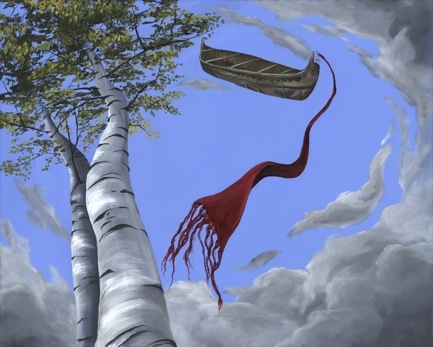Copyright © 2005 Abraham Studios
Send mail to abrahamart@gmail.com with questions or comments about this site.








Copyright © 2005 Abraham Studios
Send mail to abrahamart@gmail.com with questions or comments about this site.
We enter Minnesota late at night, and pull off to sleep in a small clearing. The next morning, we stop at Kabetogama Lake Visitor’s Center in Voyageurs National Park. Here, Minnesota borders Canada and countless lakes, bays and small waterways break up the land. The park offers canoe trips through these passages, but it appears that we have just missed the boat. I wander through a maze of diagrams and dioramas before noticing a park volunteer who is dressed in oversized, but flashy clothing. Layers upon layers of fabric drape over her body and a long red sash is tied tightly around her waste like the bow on a bulky Christmas present. I ask her about her ostentatious dress and she shares the story of great men from the 1700’s.
Jacques de Noyon was the first French trader known to reach the Rainy Lake Region. While he arrived in 1688, it wasn’t until around the 1730’s that the area became known for fur trading. Fur became heavily desirable in European fashion, so acquiring beaver pelts from the Native American tribes proved to be a profitable business. French voyageurs set out from Canada on birch bark canoes to trade supplies with the Sioux, Cree, and Ojibwa Indians. Their life expectancy and pay were low, but these highly sought after careers made the men famous in town. Each layer of clothing had a purpose. For example, their oversized blouses offered comfort and relief from pestering insects. The fancy, finger-woven sash (called a ceinture fleche) had many uses, one being to prevent hernias like the modern-day weightlifting belt.
I am interested in the history of this place, but know it won’t be long until I forget the dates and details. What I will remember is that bright red scarf, and the feeling that the area created in me. We leave the park and set off to discover romantic architecture in the “Twin Cities.” The gothic design of St. Paul’s Cathedral and the detailed beauty of the Victorian houses on Summit Avenue are full of style and grandeur. However, when we stand in front of Frank Gehry’s building (The Weisman Museum), I’m a little disappointed. With broken lines and a cubistic style, the building looks as if it has jumped straight out of a Picasso masterpiece. I admire the design, but the shiny metal surface reminds me of aluminum cans, making the structure appear cheap and unsubstantial. This museum lacks a feeling of permanence, and I feel the same about the newly built Guthrie, designed by Jean Nouvel. Modern works definitely make a splash, but in this case I prefer the classic styles of St. Mary’s Basilica and the Minneapolis Institute of the Arts.
We visit the Mall of America and stand in front of the famous “Spoonbridge and Cherry” sculpture before attending an artists’ talk at the Walker Center. The exhibit is called “Ordinary Culture,” and for the record, there is nothing ordinary about these three artists. Despite the excitement of our many adventures, my favorite experience is meeting the husband and wife owners of Homewood Studios. George Roberts, gallery owner and retired English teacher, takes us into his studio where he creates art in book form. A vast collection of paper, typography, and book binding supplies fill the space. His
work and outlook on life are fascinating. We talk to him and his wife until dusk, reminding Alfonso and I that landmarks and landscapes are incredible, but the people who walk amongst us are truly inspirational.










